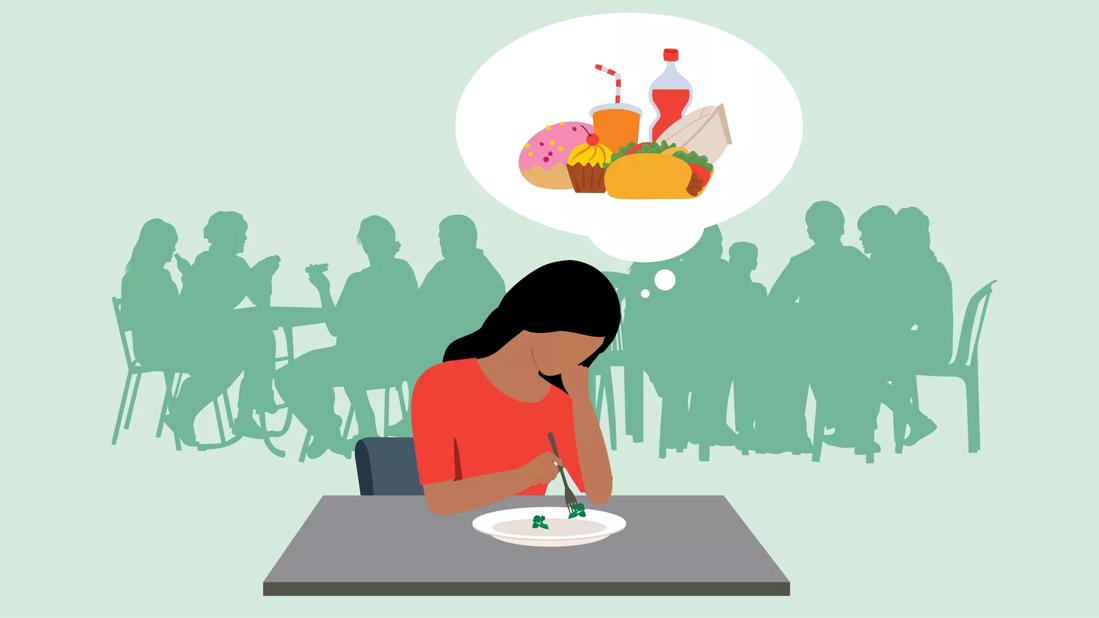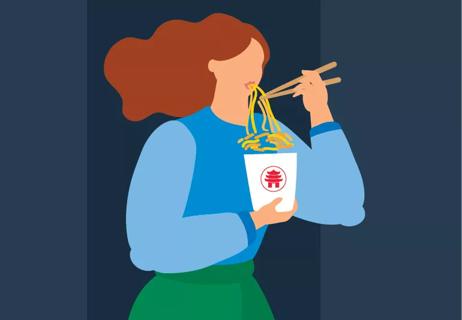Having overweight and disordered eating is a high-risk combination that often gets dismissed or overlooked

We’ve heard the phrase before, “Never judge a book by its cover.” As we strive to live in a body-positive world and we’re forced to confront online thinspiration, it’s perhaps truer now than ever before.
Advertisement
Cleveland Clinic is a non-profit academic medical center. Advertising on our site helps support our mission. We do not endorse non-Cleveland Clinic products or services. Policy
Despite outward appearances, you never quite know every detail that someone is dealing with in terms of their mental, emotional, behavioral or cognitive health.
And when it comes to identifying symptoms or assigning a clinical diagnosis for disordered eating, the same rules apply — someone’s physical appearance doesn’t always provide a full and honest picture of someone’s actual health. Someone who appears to have average weight or overweight can be living with anorexia and be experiencing the same severity of symptoms as someone who’s underweight.
“When we think of eating disorders and how they’re diagnosed, they’re defined by a committee of experts who review the literature and argue and discuss what the criteria are and what are the cutoffs,” says psychologist and obesity specialist Leslie Heinberg, PhD. “Although that has to happen, it doesn’t always describe every individual’s experience very well.”
No matter where we fall on the scale in terms of our weight or body mass index (BMI), it’s up to us to destigmatize the myths behind eating disorders, recognize the symptoms of disordered eating and ask for assistance from a healthcare provider when we need treatment.
Eating disorders are defined by different sets of characteristics that set them apart from one another based on certain criteria outlined in the Diagnostic and Statistical Manual of Mental Illnesses (DSM-5).
Advertisement
The three criteria for diagnosing anorexia, for example, are:
“Conditions like anorexia have been defined around being of low weight as one of the criteria that’s most important, and that definition ignores the majority of people who have atypical anorexia,” explains Dr. Heinberg. “One of the things most commonly that makes them atypical is that they don’t fit into the diagnostic bucket because of their weight or their body mass index. But people can have lots of symptoms of anorexia across the BMI spectrum.”
You can develop disordered eating at any weight and stage of life. Disordered eating as a whole is commonly associated with physical characteristics of malnutrition like low body weight, dizziness and low blood pressure.
But there are other less noticeable and more common symptoms associated with disordered eating that involve behaviors, emotions, beliefs and mental health conditions that can influence, drive or worsen the severity of your symptoms. And much like how our weight can rise and fall on a spectrum, disordered eating exists on a similar continuum.
“We make these arbitrary distinctions with eating disorders — from binge eating to bulimia, to anorexia to avoidant/restrictive food intake disorder (ARFID) — all of these things occur on a continuum,” notes Dr. Heinberg. “For lots of people, depending on where they are in the course of their illness, they can move along this continuum over time.”
To highlight this, Dr. Heinberg uses an example of someone who was living with obesity years ago and then develops anorexia. Over time, as they lose more weight at rapid increments, they might get to a point where they have underweight. When they begin binge eating, they might experience a period of bulimia until they recognize they’re causing damage to their body, and then they continue binge eating. These interchangeable periods of bulimia, binge eating and fluctuations in weight loss and weight gain then perpetuate the cycle of disordered eating that originally began with anorexia.
“Medically, we put people into buckets around diagnoses, but it’s a continuum,” reiterated Dr. Heinberg “And for lots of people, they move between diagnoses depending on where they are in their life, how they’re coping with stress and what’s going on in their environment.”
Advertisement
The thing is, your weight is just one small piece of the puzzle to your overall health — so much so, that we’re starting to change the way we talk about living with obesity and having overweight. And that combination of having obesity and developing eating disorders makes for an often overlooked and highly vulnerable at-risk patient population.
“Obesity is not one disease. There are many different types of obesities, and just like with cancer, we would not say, ‘All cancers are exactly alike, and they all need the exact same treatment,’” clarifies Dr. Heinberg.
“Similarly, disordered eating is really complex with lots and lots of different causes. The majority of people who have obesity do not have an eating disorder, but eating disorders are more common in people living with obesity, and there is significant overlap between the two.”
Anorexia is traditionally defined as having a BMI of below 18.5 kg/m2 (kilograms per square meter) — but that same definition doesn’t consider the lived experiences of those who have anorexia while having higher BMIs and living with obesity.
To illustrate, Dr. Heinberg presents an example of someone who started at 350 pounds. By relying on disordered eating behaviors — like purging, food restriction and compulsive exercising — they lose 50 pounds very quickly.
Advertisement
Their healthcare providers, family and friends reinforce those behaviors by praising them for losing so much weight because, on the surface, it appears like it’s a good thing that’s occurring as part of their weight loss journey. But behind the scenes, the person living with anorexia may be dealing with other symptoms and side effects that go unnoticed or ignored, including:
“They may go to the doctor and the doctor praises them for losing this weight, even if they’re losing weight because they’re not eating, and if they do eat, they make themselves throw up and they are completely preoccupied by this,” illustrates Dr. Heinberg.
“The world treats weight loss as a good thing. But at 300 pounds, though they may still be clinically overweight and they’re not in that underweight category that we would clinically call anorexia, in every other aspect, they’re going to be much more similar to that underweight patient in terms of their behaviors, their emotions, their thoughts and cognitions.”
Advertisement
In the last decade, studies have shown that up to 45% of people seeking in-patient treatment for disordered eating were at or above their expected weight, highlighting an increased need for diagnosis and treatment for those living with obesity and disordered eating.
“The problem is, we can, unfortunately, end up missing a lot of these patients who really need treatment and support,” states Dr. Heinberg. “It’s easy to get caught up in thinking that if people are happy that they’ve lost 50 pounds, they should lose another 50 pounds. But if somebody started at a much lower weight and lost 50 pounds, everybody would be very concerned and say they aren’t eating and want to take them to a doctor right away because it’s concerning when you can see the physical signs of malnutrition. But we need to start thinking about this beyond mere appearances and start thinking about it as a disease that runs much deeper and can affect everyone of any size and shape.”
One of the hardest things about disordered eating is recognizing the warning signs. Some of those warning signs, says Dr. Heinberg, involve ritual behaviors like purging and food restriction. But even those behaviors can have subtle nuances to them.
Purging can involve:
“Even going to the gym for 2.5 hours because you had candy a couple nights ago can be a cause for concern because it’s considered purging behavior when it becomes excessive, disruptive or it’s a behavior associated with feelings of shame, guilt, remorse or lack of self-worth,” says Dr. Heinberg.
And it’s that internal self-imposed judgmental piece that’s perhaps most important when you’re trying to determine the difference between healthy intermittent fasting and hyper-focused restrictions that could lead to malnutrition and complex medical complications.
“There are other behaviors that can go on with a preoccupation with weight and fitness where you’re spending more time thinking about this than not thinking about this,” continues Dr. Heinberg.
“If you do eat something, you might feel extreme guilt or disgust in yourself. You might really beat yourself up, not just immediately after eating, but the whole next day when you’re feeling very distressed, guilty and depressed about it. You might feel out of control. And maybe you plan not to binge eat or you plan not to purge, but those brakes just aren’t working and you feel like you can’t control your behavior and there’s a loss of control around eating or these eating disorder behaviors.”
If you recognize any of these signs and symptoms, it’s time to ask for help.
“If you’re engaging in severe restriction or purging, often, those are very difficult to stop by yourself, and eating disorders tend to take on a life of their own,” recognizes Dr. Heinberg. “A starved brain does not make rational decisions and it tends to self-perpetuate. Often, once people get into the more severe range, they really do need help making those changes.”
Studies show that when you’re living with obesity and dealing with disordered eating, the best treatment options handle both sides of the equation with a multidisciplinary approach. It’s not just about helping you achieve a healthy weight — it’s also about making sure you’re emotionally and mentally equipped with the right tools so you feel safe and secure in your body.
“It can be a little anxiety-producing to think, If I decide to work on my weight, will I fall back into these disordered eating behaviors? And that’s where I think having multidisciplinary treatment and supervision and support is really important,” says Dr. Heinberg.
You might work with a cognitive behavioral therapist or psychologist who can help you build strategies, coping mechanisms and healthier alternatives related to your eating, exercise and physical fitness behaviors.
You might work with a dietitian who can help you figure out how many calories you need in a day, the kinds of foods you might love, ways to incorporate healthy snacks between meals and what nutritional plans to follow to make sure you’re getting the right amount of nutrients you need for your body.
And you might have a medical team who can provide weight loss medications and monitor your weight over time, along with any other underlying medical conditions you have to make sure every step of this journey is handled with care based on your own personal history with obesity, weight management and disordered eating.
At the same time, you’re identifying measurable goals for your physical fitness. You’re also rewiring the way you think about weight. The goal: Fine-tuning the relationships you have with food, your body and your mind.
You’re more than the sum of your parts. You’re more than the number on the scale. Your worth extends beyond the behaviors that negatively affect your health. And you won’t be alone when you come out on the other side of this a whole person, still intact.
“Treatment really relies upon behavioral psychological treatment, nutritional therapy and, sometimes, the use of medications,” says Dr. Heinberg. “That kind of multidisciplinary treatment is effective across a wide spectrum.”
Learn more about our editorial process.
Advertisement

An obsession with eating ‘clean’ or ‘healthy’ can be both physically and emotionally damaging

Eating disorders are diagnosable mental health conditions, while disordered eating is unhealthy eating behavior that doesn’t meet the criteria for a diagnosis

This is an eating pattern that doesn’t meet the criteria for an eating disorder but can still be harmful

While social media content doesn’t create eating disorders, it can easily exacerbate them

Get moving, avoid the scale and be kind to yourself — plus, learn your triggers

It may be mistaken for digestive problems

Don’t let emotions trigger bad food habits

They cause junk food cravings at night

Babies can get congested easily, but you can calm their cough by keeping them hydrated, using nasal drops and running a humidifier

Weight loss may cause loose, sagging skin and muscle loss to your rear

Several conditions, like vitiligo and fungal infection, can cause a loss of pigmentation, leading to white spots or patches on your skin